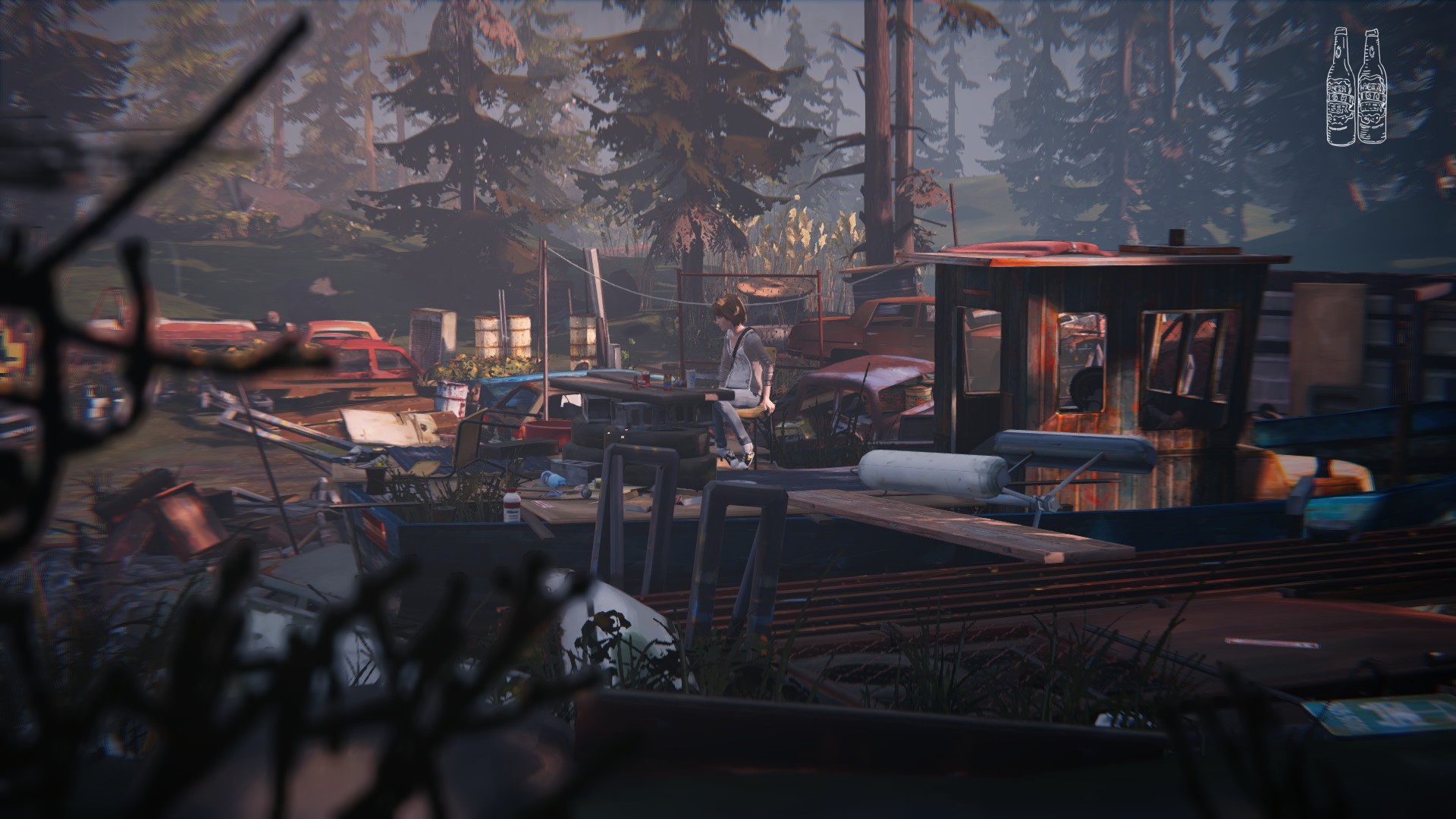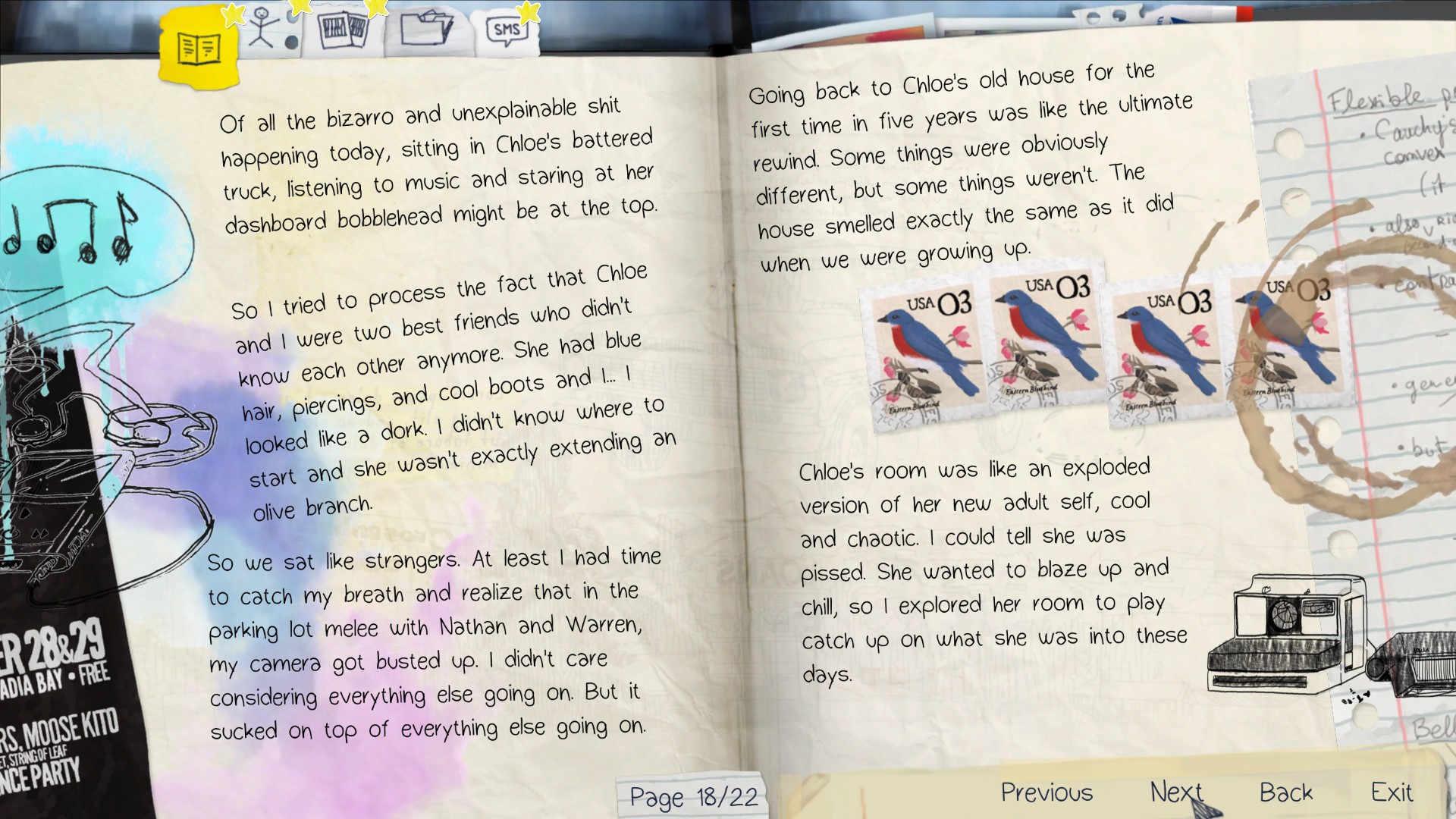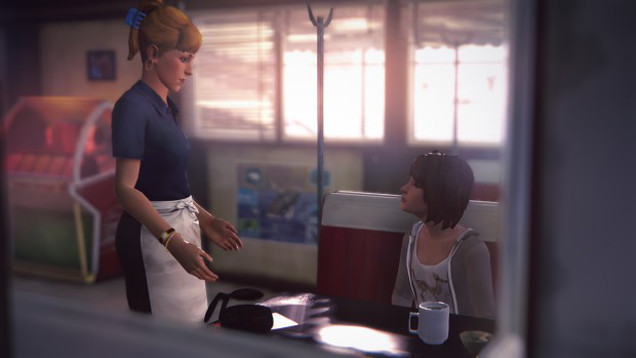My favourite thing about Life is Strange is that it encourages you to be present in the moment. At the beginning of the second episode, shy photography student Max awakens in her dorm room to the sound of Alt-J, and there’s no hurry to get up. You can lie there with her for as long as you want, while the song plays in the background.
Later, there are ample moments for reflection; opportunities to sit with Max in an oddly beautiful junkyard, her back up against a tree stump, just looking around and listening to the wind and the birds. I rarely do this in my real life. I should make more time for it.
It engenders a sense of presence that goes a long way towards ameliorating the less perfect things about Life is Strange so far: the weird lip-synching, the slightly over-eager script, the fact that the dialogue was clearly recorded in separate sessions (making some of the character interplay sound stilted, with emphasis on the wrong words or lines). At least one of those things is better in this episode than it was in the last: though – Life is Strange‘s first episode had a habit of over-explaining things, but here there are fewer redundant lines that snap you out of the moment. There’s still the odd teen-speak clanger (“Hey, Max, I wanted to rap about that action yesterday”), but as a whole it still comes across as overwhelmingly earnest. It is still one of exactly three games I’ve ever played that has successfully communicated some of what it’s like to be a teenage girl.

After discovering that she has time-rewinding powers in the first episode, Max really puts them through their paces in this one. A good half of this episode involves slightly tedious “tests” where Max — reunited with her childhood best friend, Chloe, who has since turned into something of a teenaged tearaway — predicts the future, or guesses what people have in their pockets, or rewinds dangerous situations to change the outcome. Through all of this she’s reconnecting with Chloe, but it feels slightly artificial; a way to test out the implications of the memory-rewind mechanic, rather than a sequence of believable moments.
The opening and close of the episode are more effective, because the focus shifts from Max’s power to the lives of people around her. Episode 2 isn’t actually about Max so much as it’s about one of her classmates, Kate, who is dealing with an invasion of privacy that I fear is becoming fairly common for young girls: someone took a video of her, well, behaving like a teenager at a party and stuck it up online, and her guilt and extreme sense of shame about it send her into a spiral that Max must try to help her out of. This storyline feels powerful and relevant, to the extent that I wonder whether Life is Strange might have peaked too soon.
There are several events in this episode that play out differently depending on how much you’ve been paying attention to what’s going on, and how you choose to respond to it. Effects from the choices that I’d made in the first episode were definitely felt, and it certainly feels like the story is going to diverge significantly from the next episode onwards. Again, the memory-rewind mechanic allows you to subvert the traditional course of a choice-based game by trying out different options before you decide on one — but there’s one crucial juncture in that episode where your power is taken away, and you have to live with the things you do and say (and their consequences). I still think that the memory-rewind mechanic is a splash of genius for this genre; taking it away at a crucial moment is another one.

The settings, meanwhile, are redolent of the same nostalgic Americana that the first episode evoked so effectively, especially the classic run-down diner where Chloe’s mother works. Hidden around these areas are things to look at and capture if you take the time to do so. Life is Strange encourages you to look around, read things, take photographs and savour the moment. (Another of my favourite things about the game is Max’s doodle-adorned journal, which feels personal and believable as a document of adolescence.)
On the strength of these two episodes alone, Life is Strange is turning into one of the more memorable games of the year. It’s a disarmingly humane story and has a real way with the relatively mundane details of everyday teenage-life – and this second episode proves that it can cope with more. If you’ve not tried it already, you definitely should.


Comments
14 responses to “You Really Should Be Playing Life Is Strange”
Sold then, was considering grabbing this last night, love the telltale games (tales from the borderlands episode 2 was fantastic, the broment and the “by now I am in stasis” were high points). Reviews all seem pretty positive outside of the odd script and delivery issues but I can get past that.
This game kinda reminds me of telltale, but the game engine actually works!
I can’t believe how short the second episode was! I saved at where I thought was half way, came back to watch a video of the characters and the episode ending! I wasn’t impressed after the month wait since episode 1.
Yeah I agree on that, it did feel a lot shorter but still enjoyed it.
I enjoyed it but man, that lip-syncing is really off putting. It makes me appreciate how well the Telltale games do lips. In the end I just tried not to look too closely.
It’s funny how this is a non-issue for a lot of people, yet it’s nearly a dealbreaker for some. There’s probably some really interesting psychology at play here.
This one has definitely landed on my to-be-played list. Not sure when I will find the time though, maybe when all the bloodborne craze die down.
The thing that makes this game stand-out for me, is that the choices aren’t just straight-out good and evil, like many other games make the mistake of doing, everything is a moral gray area, and you never know what decision is the “right” one, even with the ability to rewind.
I’m now sold on this game.
The demo gave me the glimpse I needed to be interested, but I’ve yet to dive into a game like this (Telltale games, mostly) without having access to all episodes. Perhaps now is the time to give an episodic game a shot and wait eagerly for each new instalment.
The demo even had some weird lip-syncing moments, but I think I can look past them for the unique and somewhat-peaceful gameplay. Plus, it will be a nice counter to the dread and pain of Bloodborne…
Lip sync is a problem but ignoring that the game is fantastic. Play it people!
At the start, the song actually finishes, and then you can continue to lay there in silence.
Definitely interested, but I think I’ll wait until it’s finished and I can play it all at once. Will hopefully be finished with Bloodborne by then.
Sold! I’ll wait until it is all out though. I like to binge on these types of games!
Lip sync isn’t a problem being a mature adult who is more interested in playing something than judging things to an extent I can comprehend. It’s a great game, though. A few situations made me consider my choices in ways no game ever has. I wonder if people are actually going to even understand the complex perspectives and the game almost begging for empathy in the story and characters, however, especially if they’re concerned about the lip sync or kids talking weird even though they actually do.
Shy teenage female character who doesn’t shoot guns and struggles with insecurities, families, friends and an uncertain future whilst navigating a world seemingly spiralling out of control – this game would be dead in the water for people if it had subtitles. (“I don’t want to READ a game/movie!”)
One of the best games I’ve played this year…
Looks very interesting. I’ll hold out until all of the episodes are released.